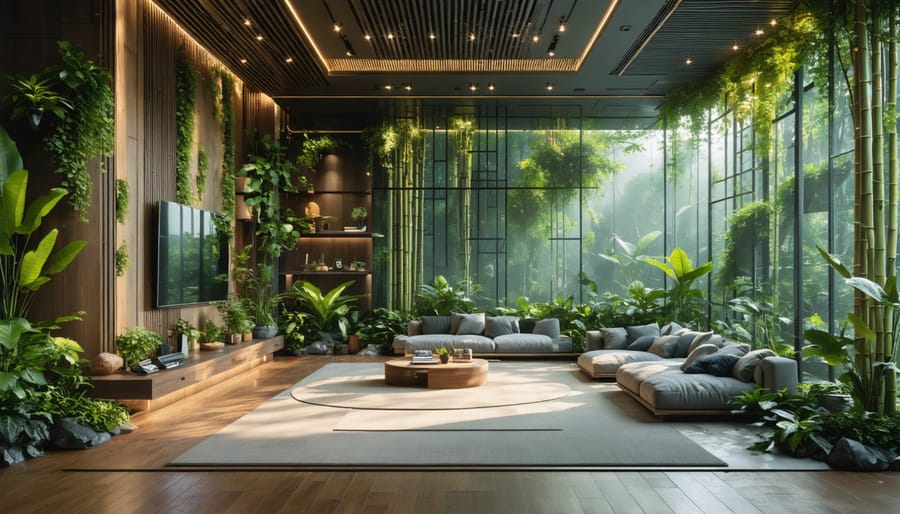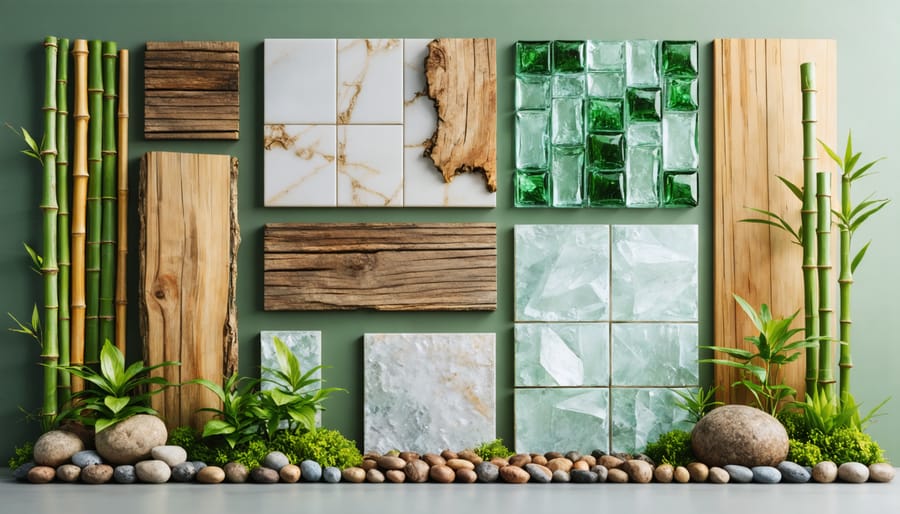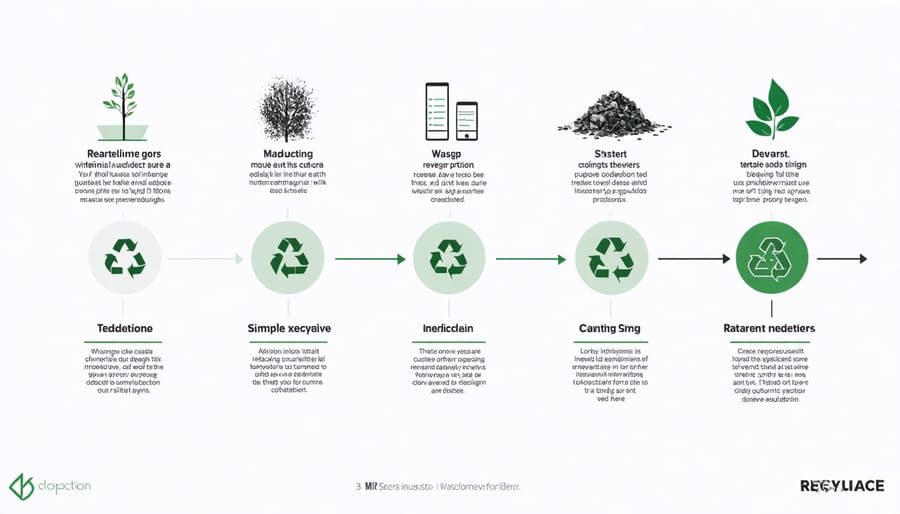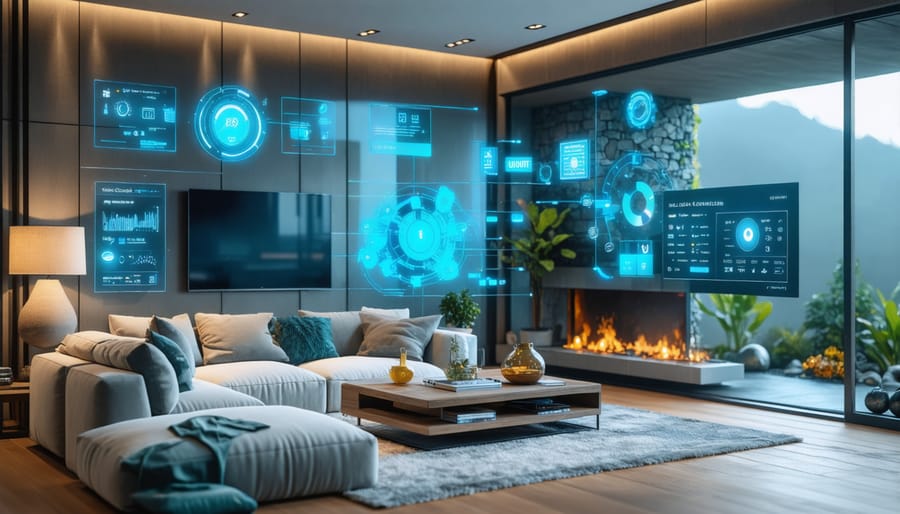
Smart Sustainability: Transform Your Interior Design Projects into Eco-friendly Masterpieces
Transform project management into a sustainable powerhouse by integrating environmental responsibility with business success. When planning your sustainable renovation, every decision impacts both your bottom line and our planet’s future. Smart resource allocation, waste reduction strategies, and energy-efficient practices now define modern project success metrics.
Today’s project managers must balance traditional objectives—time, cost, and quality—with environmental stewardship and social responsibility. By implementing digital documentation systems, choosing eco-certified materials, and establishing clear sustainability KPIs, projects can achieve both profitability and environmental excellence.
Leading organizations recognize that sustainable project management isn’t just an environmental choice—it’s a competitive advantage. Energy-efficient designs, waste reduction protocols, and renewable material sourcing create long-term cost savings while building brand value. This approach transforms traditional project constraints into opportunities for innovation and market leadership.
The future of project management lies in this triple bottom line approach: people, planet, and profit working in harmony to deliver results that matter. Whether managing a small home renovation or overseeing large-scale commercial developments, sustainable practices are no longer optional—they’re essential for project success in our resource-conscious world.
The Building Blocks of Sustainable Interior Design Projects
Material Selection and Sourcing
Selecting sustainable materials is a crucial step in any eco-conscious project. When evaluating materials for your design project, start by assessing your client sustainability requirements and environmental goals. Look for materials with recognized certifications like FSC (Forest Stewardship Council) for wood products, GREENGUARD for low chemical emissions, and Energy Star for appliances and fixtures.
Prioritize locally sourced materials whenever possible to reduce transportation emissions and support your community’s economy. Consider materials with high recycled content, biodegradable options, or those that can be easily recycled at the end of their lifecycle. Bamboo, reclaimed wood, recycled metal and glass, and low-VOC finishes are excellent sustainable choices.
Create a supplier evaluation checklist that includes:
– Distance from project site
– Environmental certifications
– Manufacturing processes
– Packaging practices
– Waste reduction policies
Don’t forget to factor in durability and maintenance requirements. Materials that last longer and require minimal upkeep often have a lower environmental impact over their lifetime. Keep detailed records of material sources and certifications for project documentation and future reference.
Remember to balance aesthetic requirements with environmental impact. Many eco-friendly materials now come in stylish options that don’t compromise on design quality or visual appeal.

Energy Efficiency Planning
Energy efficiency is at the heart of sustainable project management, and implementing the right strategies can lead to significant cost savings while reducing environmental impact. Start by conducting an energy audit of your space to identify areas where improvements can make the biggest difference. This initial assessment will help you prioritize your efforts and investments.
Consider incorporating smart lighting solutions, such as LED fixtures with motion sensors and daylight harvesting capabilities. These systems automatically adjust brightness levels based on natural light availability and room occupancy, potentially reducing lighting energy consumption by up to 75%.
When selecting appliances and equipment, look for ENERGY STAR certification, which indicates superior energy efficiency. Pay special attention to HVAC systems, as they typically account for the largest portion of energy usage in both residential and commercial spaces. Modern, energy-efficient HVAC systems can be integrated with smart thermostats to optimize performance based on occupancy patterns and weather conditions.
Building envelope improvements are another crucial aspect of energy efficiency planning. This includes proper insulation, weather stripping, and high-performance windows. Consider installing programmable window treatments that can automatically adjust throughout the day to maximize natural light while minimizing heat gain or loss.
Don’t overlook the power of passive design elements. Strategic placement of windows, proper orientation of the space, and the use of natural ventilation can significantly reduce your reliance on artificial lighting and mechanical cooling systems.
Remember to regularly monitor and maintain all energy-efficient systems to ensure they continue performing at optimal levels. This ongoing attention to performance is key to achieving long-term sustainability goals.
Project Timeline and Resource Management
Budget-Friendly Green Solutions
Implementing sustainable design doesn’t have to break the bank. By starting with a well-structured project planning template, you can identify cost-effective green solutions that deliver both environmental and financial benefits. Consider starting with LED lighting upgrades, which typically pay for themselves within two years through reduced energy costs. Installing programmable thermostats and smart power strips can cut energy waste while requiring minimal upfront investment.
Repurposing existing materials is another budget-friendly approach. Before demolishing, evaluate what can be refinished or reimagined. Old wooden furniture can be restored, and outdated cabinets can be transformed with low-VOC paint and new hardware. For flooring, consider sustainable bamboo or reclaimed wood, which often costs less than new hardwood while offering superior durability.
Water-saving fixtures like low-flow faucets and dual-flush toilets typically cost only slightly more than standard options but can reduce water bills by up to 50%. When it comes to insulation, natural materials like recycled denim or cellulose often match or beat the price of fiberglass while providing better thermal performance.
For window treatments, cellular shades offer excellent insulation at a fraction of the cost of window replacement. Additionally, indoor plants serve as natural air purifiers while adding aesthetic value without significant expense. Remember, many utility companies offer rebates for energy-efficient upgrades, making sustainable choices even more affordable.

Waste Reduction Strategies
Effective waste reduction is a cornerstone of sustainable project management, and there are several practical ways to minimize waste during your design projects. Start by implementing a detailed materials planning process – carefully measure spaces and calculate exact material needs to avoid over-purchasing. Consider ordering samples before making bulk purchases to ensure materials meet your expectations and prevent waste from unsuitable products.
Create a materials reuse strategy by designating a storage area for leftover materials from previous projects. These can often be incorporated into future designs or used for smaller accent pieces. When demolishing or removing existing elements, salvage materials that are in good condition for potential reuse or donation to local building material recycling centers.
Digital planning tools can significantly reduce paper waste – use project management apps and digital documentation instead of printing multiple copies. When physical samples are necessary, opt for smaller sizes or shared sample books that can be returned to suppliers.
Partner with suppliers who offer take-back programs for excess materials and packaging. Many manufacturers now provide services to collect and recycle their products properly. For packaging materials, establish a relationship with local recycling facilities or find creative ways to repurpose them in your projects.
Set up clearly marked waste sorting stations on-site to separate recyclables, reusable materials, and actual waste. Train your team on proper waste sorting procedures and make it easy to follow through with conveniently placed bins and clear signage. Regular monitoring of waste output helps identify areas where further reduction is possible.
Technology Integration for Sustainable Spaces
Smart Home Features
Smart home technology plays a crucial role in sustainable project management, offering innovative solutions that reduce energy consumption while enhancing comfort and convenience. The key to successful implementation lies in selecting and integrating the right features for your specific needs.
Start with a smart thermostat as your foundation. These devices learn your schedule and preferences, automatically adjusting temperature settings to optimize energy usage. They can reduce heating and cooling costs by up to 15% annually while maintaining comfortable living conditions.
Intelligent lighting systems are another essential component. Motion sensors and programmable LED fixtures can significantly decrease electricity consumption. Consider installing smart switches that allow remote control via smartphone apps, enabling you to turn off forgotten lights from anywhere.
Energy monitoring systems provide real-time data about your power usage, helping you identify and eliminate energy waste. These systems can track individual appliance consumption and suggest optimization strategies based on your usage patterns.
For water conservation, smart irrigation systems use weather data and soil moisture sensors to water plants only when necessary. Inside, smart water meters can detect leaks and monitor consumption, helping you maintain sustainable water usage.
Automated window treatments can maximize natural light and regulate indoor temperatures. During summer, they can close automatically during peak heat hours, reducing the load on your cooling system.
Remember to choose devices that are compatible with your existing home automation platform to ensure seamless integration and easy management through a single interface.

Monitoring and Control Systems
Effective monitoring and control systems are the backbone of any sustainable project, helping you stay on track with your eco-friendly goals while maintaining project efficiency. Start by implementing a digital dashboard that tracks key sustainability metrics like energy usage, waste reduction, and resource consumption in real-time. Many modern project management tools now include built-in sustainability trackers that make this process simple and intuitive.
Set up regular check-ins and assessments using a combination of automated monitoring systems and manual reviews. For example, smart meters can track energy consumption patterns, while waste management logs help monitor recycling efforts. Create a simple spreadsheet or use project management software to document progress and identify areas needing improvement.
Don’t forget to establish clear benchmarks and KPIs for your sustainable practices. These might include monthly energy savings targets, waste reduction goals, or water conservation metrics. Regular reporting helps keep team members accountable and engaged in sustainability efforts.
Consider implementing a feedback system where team members can report sustainability concerns or suggest improvements. This creates a culture of continuous improvement and helps catch potential issues before they become problems. Additionally, use automated alerts to notify relevant team members when sustainability metrics fall outside acceptable ranges, allowing for quick corrective action.
Remember to regularly update your monitoring systems as new technologies and best practices emerge. This ensures your sustainable project management stays current and effective over the long term.
Measuring Success and Certification
Performance Metrics
Measuring the success of sustainable projects requires a well-defined set of performance metrics. Start by establishing baseline measurements for energy consumption, water usage, and waste production before implementing any changes. These benchmarks will help you track improvements over time.
Key performance indicators (KPIs) should include both environmental and economic metrics. Monitor monthly utility bills, recycling rates, and the percentage of eco-friendly materials used in your projects. When tracking sustainable project progress, document both short-term wins and long-term improvements.
Consider measuring indoor air quality, daylight utilization, and occupant satisfaction through regular surveys. For renovation projects, track the amount of salvaged materials used and construction waste diverted from landfills. Calculate your carbon footprint reduction by comparing pre- and post-project energy consumption.
Financial metrics should include initial investment costs, ongoing operational savings, and return on investment timelines. Don’t forget to measure social impact factors like improved comfort levels, productivity gains, and increased property value. Regular monitoring and adjustment of these metrics ensure your sustainable projects stay on track and deliver meaningful results.
Certification Options
When pursuing sustainable interior design projects, several respected certification options can validate your commitment to eco-friendly practices. LEED (Leadership in Energy and Environmental Design) certification remains the gold standard, offering different levels of recognition based on your project’s sustainable features and overall environmental impact.
For residential projects, WELL certification focuses on creating spaces that promote occupant health and wellness, while incorporating sustainable practices. The Living Building Challenge provides another rigorous option, requiring projects to be net-zero energy, waste, and water.
For furniture and materials, look for Forest Stewardship Council (FSC) certification, which ensures wood products come from responsibly managed forests. GREENGUARD certification verifies low chemical emissions from products, making it essential for indoor air quality considerations.
The Energy Star certification program helps identify energy-efficient appliances and lighting fixtures, while WaterSense certification highlights water-saving fixtures and systems. For overall project management, consider the Green Project Management (GPM-b) certification, which specifically focuses on sustainable project management practices.
Remember that certification requirements and costs vary, so choose the options that best align with your project goals and budget while delivering meaningful environmental benefits.
As we’ve explored throughout this guide, sustainable project management in interior design isn’t just a trend – it’s a vital approach for creating spaces that benefit both people and the planet. By incorporating eco-friendly materials, energy-efficient solutions, and waste reduction strategies, you can make a significant positive impact while still achieving stunning design results.
Remember that sustainable project management is a journey, not a destination. Start with small, manageable changes like choosing low-VOC paints or energy-efficient lighting, then gradually expand your sustainable practices as you become more comfortable with the process. Keep track of your progress through careful documentation and measurement of resource usage, costs, and environmental impact.
The key to success lies in balancing aesthetics, functionality, and sustainability. Don’t feel pressured to transform everything at once – even small changes can lead to meaningful results. Consider starting with a single room or focusing on one aspect, such as lighting or materials, before expanding your sustainable practices throughout your space.
By embracing sustainable project management principles, you’re not just creating beautiful interiors – you’re contributing to a healthier planet while potentially reducing long-term costs. Take the knowledge you’ve gained here and start implementing these practices in your next project. The future of interior design is sustainable, and you’re now equipped to be part of that positive change.
